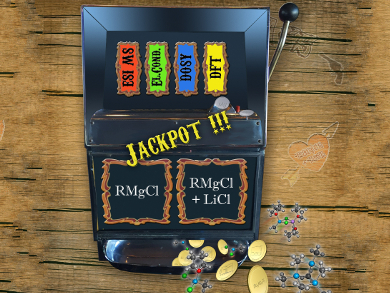Grignard reagents, RMgCl, were discovered in 1900 by the Nobel Prize-winning chemist whose name they bear. They are important reagents used in synthesis for a plethora of reactions. However, despite their extensive use, the exact nature of the Grignard species in solution in both the classic and “turbo” variations (RMg·LiCl) is not well known, partially due to their high sensitivity to oxygen and due to the fact that trace amounts of water make a detailed analysis very complicated.
Konrad Koszinowski and colleagues at the University of Göttingen, Germany, have successfully analyzed a range of organomagnesium species in solution, both with and without the addition of stoichiometric amounts of LiCl. They determined the way that LiCl aids in the turbo-charging of classical Grignard reagents. The analyses were conducted using fine-tuned electrospray-ionization mass spectrometry (ESI-MS), electrical conductivity measurements, and NMR spectroscopy in combination with quantum chemical calculations.
A key discovery of their study is that small portions of non-turbo-charged Grignard reagent form anionic ate complexes in ethereal solutions. These are very electron-rich and therefore likely more nucleophilic than the Grignard reagent itself. Upon addition of LiCl, the abundance of these ate complexes is greatly enhanced, thus, the reactant is “turbo-charged”.
- Association and Dissociation of Grignard Reagents RMgCl and Their Turbo Variant RMgCl·LiCl,
Christoph Schnegelsberg, Sebastian Bachmann, Marlene Kolter, Thomas Auth, Michael John, Dietmar Stalke, Konrad Koszinowski,
Chem. Eur. J. 2016.
DOI: 10.1002/chem.201600699




